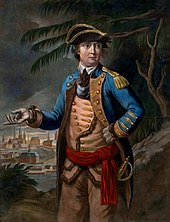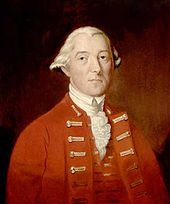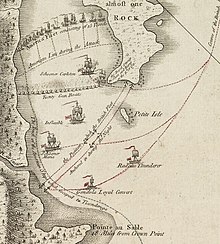Military career of Benedict Arnold, 1775–1776
Benedict Arnold V | |
|---|---|
 Benedict Arnold Copy of engraving by H.B. Hall after John Trumbull | |
| Born | January 14, 1741 Norwich, Connecticut |
| Died | June 14, 1801 (aged 60) London, England |
| Place of burial | London |
| Service/ | British colonial militia Continental Army British Army |
| Years of service | British colonial militia: 1757, 1775 Continental Army: 1775–1780 British Army: 1780–1781 |
| Commands held | Fort Ticonderoga (June 1775) Quebec City (siege, January–April 1776) Montreal (April–June 1776) Lake Champlain fleet (August–October 1776) |
| Battles/wars | American Revolutionary War, 1775–1776
|
| Awards | promotion to brigadier general |
The military career of Benedict Arnold in 1775 and 1776 covers many of the military actions that occurred in the northernmost
When the
Arnold then traveled to Montreal, where he served as military commander of the city until forced to retreat by an advancing British army that had arrived at Quebec in May. He presided over the rear of the Continental Army's retreat from Saint-Jean, where he was reported to be the last person to leave before the British arrived. He then directed the construction of a fleet to defend Lake Champlain, which was defeated in the October 1776 Battle of Valcour Island. His actions at Saint-Jean and Valcour Island played a notable role in delaying the British advance against Ticonderoga until 1777.
During these actions, Arnold made a number of friends and a larger number of enemies within the army power structure and in Congress. The actions of some of these political enemies resulted in
Background
Early Revolutionary War
In March 1775, a group of 65 New Haven residents formed the Governor's Second Company of Connecticut Guards. Arnold was chosen as their captain, and he organized training and exercises in preparation for war.

During the march, Arnold encountered Connecticut legislator and militia Colonel
On May 10, 1775, Fort Ticonderoga was assaulted in a dawn attack and taken without a battle, the colonial forces having surprised the outnumbered British garrison.

After returning to Ticonderoga, Arnold began to exert more authority over the place as Allen's men drifted away. However, a Connecticut force of 1,000 men under Colonel Benjamin Hinman arrived in June with orders placing him in command with Arnold as his subordinate. This act angered Arnold, who felt his efforts on behalf of the revolution were not being recognized; he resigned his commission and headed for his home in Connecticut.[17] Arnold's angry response to the loss of command led some members of Congress to dislike him in spite of his military contributions.[18] Congressional opinion of Arnold was also negatively affected by reports circulated by two men that Arnold came to consider enemies. John Brown and James Easton were two of Allen's lieutenants who had traveled to Massachusetts and Philadelphia to report on the action. While their characterizations of Arnold's behavior were accurate, he apparently came to believe that they had probably slandered him, and later interactions with both men were marked by conflict.[19] In an encounter between Arnold and Easton in June, Easton slighted Arnold's authority, to which Arnold responded by challenging the other man to a duel. Easton demurred, and Arnold, in his account of the affair, "took the Liberty of Breaking his head".[20] After Arnold resigned his Massachusetts commission, the state's Committee of Safety appointed Easton to take over the Massachusetts troops at Ticonderoga.[21]
When he reached Albany, Arnold received a letter informing him that his wife had died.[18] He also met with Major General Philip Schuyler, newly in command of the Continental Army's Northern Department,[22] with whom he established a cordial relationship. Arnold returned to New Haven, where he visited his children (now in the care of his sister Hannah) and took care of business dealings. While in New Haven he suffered his first attacks of gout, which plagued him for the rest of his life.[23]
Quebec expedition
While at Ticonderoga, both Arnold and Allen lobbied Congress with the idea of taking Quebec from the British, as it was lightly defended.

Arnold, deprived of the opportunity to lead that expedition, went to Cambridge and proposed to George Washington that a second force, in concert with Schuyler's, attack by traveling through the wilderness of what is now Maine to Quebec City.[27] Washington and Schuyler approved the idea, and Washington gave Arnold a colonel's commission in the Continental Army and leadership of the expedition.[28] Arnold used as a guide for the expedition a map and journal he had acquired that were made by John Montresor, a British engineer who mapped the route in 1761. The journal was vague in some details, and, unknown to Arnold, the map contained deliberate omissions to reduce its value to military opponents.[29][30]
The
The British had been alerted to Arnold's approach and had destroyed all of the boats on the river's southern banks. Although two warships, the frigate Lizard (26 guns) and the sloop-of-war Hunter (16 guns), kept up a constant patrol to prevent a river crossing, Arnold was able to procure sufficient watercraft for his men, and crossed to the Quebec City side on November 11.[34] He then realized his force was not strong enough to capture the city, so he retreated several miles and waited for Montgomery.[35]
In late August, Montgomery sailed north from Fort Ticonderoga with about 1,200 men.[36] After successfully besieging Fort Saint-Jean, he captured Montreal on November 13. The two men joined forces in early December, and with their combined force of about 1,200 soldiers, they attacked Quebec on December 31, 1775.[37] The colonial forces suffered a disastrous defeat at the hands of General Guy Carleton, governor of Quebec and commander of the British forces. Montgomery was killed leading an assault along with all but one of his officers; his men never got close to the walls. Arnold's force made a descent into the lower town. Early in the battle, Arnold was wounded in the leg, but stayed on the battlefield encouraging his troops on. Daniel Morgan's rifle company, the most successful of the American troops, fought inside the city until Morgan was cornered and forced to surrender. Many others were killed or wounded, and hundreds were taken prisoner.[38]

The remnants of the army, reduced by the battle and by expiring enlistments to some 600 men, now came under Arnold's command. Instead of retreating, Arnold maintained a minimally effective siege around the city.[39] In this time Arnold learned that he had been promoted to brigadier general in January for his success in reaching Quebec City.[40] He also had a run-in with John Brown, who was now a major and had come north with Montgomery. Montgomery had apparently promised Brown a promotion, which he then applied to Arnold to receive. Arnold, apparently still smarting over the perceived slights at Ticonderoga, denied the promotion, which Brown promptly appealed directly to Congress. Arnold's response to this threat to his authority was to accuse Brown, and also Easton, who had been present when Montgomery took Montreal but had returned south, of improperly plundering the bags of British officers. When Brown insisted on a court martial to clear his name, Arnold again refused, attempting to further smear the two men through the use of intermediaries. (Brown never received a formal hearing on Arnold's charges.)[41]
Arnold maintained the siege until the spring of 1776, when reinforcements under Brigadier General David Wooster arrived. Arnold traveled to Montreal to take up military command of that city.[42]
Retreat from Quebec
In May 1776, while a delegation of the
Arnold then began preparing to evacuate the American garrison from Montreal. Pursuant to instructions from the Congressmen he began seizing supplies from local merchants, issuing receipts for the goods that the merchants could use in compensation claims later. These goods, which were marked to identify the supplying merchant, were shipped to Fort Chambly in early June.[46] Hazen, who owned property in the area and was in command at Chambly, refused to store the goods, believing them to be goods seized improperly from merchants he knew.[47]
Arnold's anger at Hazen's act needed to be held back; the British advance up the St. Lawrence almost caught him by surprise. He was alerted that British ships were approaching the city by a messenger he sent toward Sorel for news.[48] Upon departure from the city, he ordered fires to be set in an attempt to burn the city before the British arrived, and then went to Saint-Jean, where he joined the rear of the retreating army. Arnold directed his forces to destroy by burning or sinking any ships the British could use on Lake Champlain, and set fire to the fort and nearby works.[49] Arnold is reported to have waited until the vanguard of the British army came into musket range before shooting his own horse dead and pushing off from Saint-Jean and departing up the Richelieu to Champlain.[50]

Arnold then spent the summer of 1776 coordinating the construction of a flotilla of small warships and gunboats at Skenesborough, to delay the British further by denying them free access to the lake. The British responded by building a much larger lake flotilla at Saint-Jean, which they launched in early October. The British destroyed Arnold's flotilla at the Battle of Valcour Island in mid-October, and advanced as far as Crown Point. However, winter was setting in, so General Carleton called off the advance.[17]
During the fleet's construction, Arnold ordered the arrest and trial of Hazen for dereliction of his duty with respect to the incident at Chambly.[51] Hazen, a politically well-connected figure (his commission to lead the 2nd Canadian came after appearing before Congress following the Battle of Quebec), turned the proceeding on its head, countercharging that Arnold had stolen the goods in question,[52] and that the officer responsible for transporting them, a Major Scott, had damaged them in transit.[53] Major Scott's testimony was questioned and eventually rejected by the court martial,[54] which acquitted Hazen and ordered Arnold's arrest. General Horatio Gates, then in command at Ticonderoga, dissolved the arrest warrant, citing the desperate need for Arnold's services against the expected British attack.[52] Arnold's silence in response to Hazen's accusation probably confirmed and deepened the opinions people already held of him; those favorably disposed to him perceived it as a dignified non-response to a ridiculous accusation, while those who disliked him saw it as the reaction of a man whose hand had been caught in the till. Historians continue to debate whether Arnold was actually engaged in anything illegal.[55] In the aftermath of these incidents, Congressman Samuel Chase warned Arnold that "your best friends are not your countrymen".[56]

Much of the army at Ticonderoga was ordered to march south in November, to reinforce Washington's army in the defense of New Jersey. In Albany, Arnold was again made to face formal charges. Brown and Hazen had each drawn up charges relating to earlier actions. Hazen charged defamation of character over the accusations Arnold had earlier levelled against him, and Brown accused him of a variety of minor charges, but also two peculiar ones: first, that Arnold had deliberately spread smallpox throughout the army in Quebec, and second, that Arnold had, during the raid on Saint-Jean, made "a treasonable attempt to make his escape ... to the enemy."[57] General Gates refused a hearing of Brown's charges, and a court martial, although it determined that Arnold's accusation against Hazen constituted "an aspersion of Colonel Hazen's character", imposed no punishment.[57] In the winter of 1776–77, Brown published a handbill that claimed of Arnold, "Money is this man's God, and to get enough of it he would sacrifice his country".[58]
Later military career
Washington assigned Arnold to the army's Eastern Department in December 1776 to assist in the defense of Rhode Island, where the British had occupied Newport.[59] In February 1777, Arnold was passed over for promotion to major general by Congress, prompting him to consider resigning.[60] He was visiting his family in New Haven when word arrived of a British action against an army supply depot in Danbury. Arnold and General Wooster helped to marshal militia response to this action, which culminated in the Battle of Ridgefield, where Wooster was killed and Arnold was again wounded in the leg. Arnold distinguished himself by continuing to regroup the militia companies and harrying the British forces all the way to the coast. He received promotion to major general for this action,[61] although his seniority over the earlier appointments would not be restored until after his valiant leadership in the decisive battles of Saratoga in fall 1777.[62]
While recovering from wounds incurred at Saratoga, Arnold was given military command of
Notes
- ^ There are no contemporary accounts documenting the agreement between Allen and Arnold. Pell (1929), p. 81 claims there is no documentary evidence. Boatner (1974) (pp. 1101–1102) notes that while Ward believes Arnold merely had the right to march next to Allen, Allen French argues otherwise in The Taking of Ticonderoga in 1775. Bellesiles (1995), p. 117 claims that Allen offered Arnold the right to march at the head of the column to placate Arnold.
- Citations
- ^ Brandt (1994), p. 4–6
- ^ Flexner (1953), p. 8
- ^ Flexner (1953), p. 13
- ^ Randall (1990), p. 49–53
- ^ Brandt (1994), p. 14
- ^ Randall (1990), p. 62
- ^ Brandt (1994), p. 17–18
- ^ Brandt (1994), p. 18–19
- ^ Randall (1990), p. 85
- ^ Randall (1990), p. 87
- ^ Ward (1952), Volume 1, p. 65
- ^ Randall (1990), pp. 86–90
- ^ Brandt (1994), p. 27
- ^ Randall (1990), p. 98
- ^ Nelson (2006), pp. 36–40
- ^ Nelson (2006), pp. 41–44
- ^ a b Fahey
- ^ a b Brandt (1994), p. 38
- ^ Brandt (1994), p. 29
- ^ Nelson (2006), p. 60
- ^ Nelson (2006), p. 63
- ^ Brandt (1994), p. 41
- ^ Brandt (1994), p. 42
- ^ Nelson (2006), pp. 48–49
- ^ Nelson (2006), p. 84
- ^ Nelson (2006), p. 86
- ^ Smith (1907), vol 1, pp. 398–399
- ^ Martin (1997), pp. 108–109
- ^ Smith (1903), p. 17
- ^ Desjardin, p. 54
- ^ Martin (1997), p. 116
- ^ Smith (1903), pp. 58–83
- ^ Martin (1997), pp. 121–140
- ^ Smith (1903), pp. 254–257
- ^ Smith (1907), vol 2, pp. 31–34
- ^ Smith (1907), vol 1, p. 322
- ^ Gabriel, p. 142–154
- ^ Smith (1907), vol 2, pp. 111–147
- ^ Smith (1907), vol 2, pp. 148–158
- ^ Smith (1907), vol 2, p. 189
- ^ Brandt (1994), pp. 80–81
- ^ Brandt (1994), pp. 82–83
- ^ Brandt (1994), p. 85
- ^ Martin (1997), p. 210
- ^ Brandt (1994), p. 89
- ^ Brandt (1994), pp. 90–91
- ^ Everest (1977), pp. 42–43
- ^ Brandt (1994), p. 91
- ^ Nelson (1997), p. 217
- ^ Randall (1990), pp. 237
- ^ Brandt (1994), p. 94
- ^ a b Brandt (1994), p. 96
- ^ Brandt (1994), p. 95
- ^ Martin (2002), p. 240
- ^ Brandt (1994), p. 97
- ^ Brandt (1994), p. 98
- ^ a b Brandt (1994), p. 114
- ^ Howe (1848), pp. 4–6
- ^ Randall (1990), pp. 323–325
- ^ Brandt (1994), p. 118
- ^ Randall (1990), pp. 332–334
- ^ Randall (1990), p. 372
- ^ Brandt (1994), p. 146
- ^ Brandt (1994), p. 148–149
- ^ Martin (1997), p. 428
- ^ Randall (1990), pp. 452–582
- ^ Arnold, pp. 342–348
- ^ Arnold, p. 358
- OCLC 1036787217.
- ^ Randall (1990), pp. 592–612
References
- Arnold, Isaac Newton (1905). The life of Benedict Arnold: his patriotism and his treason. Chicago: A. C. McClurg. OCLC 9993726.
- ISBN 978-0-8139-1603-3.
- Boatner, Mark Mayo III (1974) [1966]. Encyclopedia of the American Revolution. New York: McKay. ISBN 0-8117-0578-1.
- Brandt, Clare (1994). The Man in the Mirror: A Life of Benedict Arnold. New York: Random House. ISBN 0-679-40106-7.
- ISBN 0-312-33904-6.
- Everest, Allan Seymour (1977). Moses Hazen and the Canadian Refugees in the American Revolution. Syracuse University Press. ISBN 978-0-8156-0129-6.
- Fahey, Curtis (1983). "Arnold, Benedict". In Halpenny, Francess G (ed.). Dictionary of Canadian Biography. Vol. V (1801–1820) (online ed.). University of Toronto Press. Retrieved 2007-12-09.
- Flexner, James Thomas (1953). The traitor and the spy: Benedict Arnold and John André. New York: Harcourt Brace. OCLC 426158.
- Gabriel, Michael P. (2002). Major General Richard Montgomery: The Making of an American Hero. Fairleigh Dickinson Univ Press. ISBN 978-0-8386-3931-3.
- Howe, Archibald (1908). Colonel John Brown, of Pittsfield, Massachusetts, the Brave Accuser of Benedict Arnold. Optal eBooks @ www.amazon.com (December 26, 2008). Retrieved 2009-05-14.
- Martin, James Kirby (1997). Benedict Arnold: Revolutionary Hero (An American Warrior Reconsidered). New York University Press. ISBN 0-8147-5560-7. (This book is primarily about Arnold's service on the American side in the Revolution, giving overviews of the periods before the war and after he changes sides.)
- OCLC 255396879.
- Pell, John (1929). Ethan Allen. Boston: Houghton Mifflin. ISBN 978-0-8369-6919-1.
- Randall, Willard Sterne (1990). Benedict Arnold: Patriot and Traitor. William Morrow and Inc. ISBN 1-55710-034-9. This book is a comprehensive biography, and goes into great detail about Arnold's part in military operations in Quebec, as well as much of the behind-the-scenes political and military wrangling and infighting that occurred prior to his defection. It also includes detailed accounts of his negotiations with André and Clinton.
- OCLC 1013608. This book includes a reprint of Arnold's diary of his march.
- OCLC 259236.
- Ward, Christopher (1952). The War of the Revolution. New York: Macmillan. OCLC 425995.
